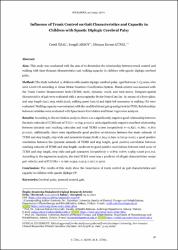Influence of Trunk Control on Gait Characteristics and Capacity in Children with Spastic Diplegic Cerebral Palsy
Özet
Aim: This study was conducted with the aim of to determine the relationship between trunk control and
walking with time-distance characteristics and walking capacity in children with spastic diplegic cerebral
palsy.
Method: The study included 14 children with spastic diplegic cerebral palsy, aged between 7-13 years, who
were Level I-II according to Gross Motor Function Classification System. Trunk control was assessed with
the Trunk Control Measurement Scale (TCMS; static, dynamic, reach, and total score). Temporo-spatial
characteristics of gait were evaluated with a posturography device NeuroCom Inc. by means of a force-plate,
and step length (cm), step width (cm), walking speed (cm/s) and right-left symmetry in walking (%) were
evaluated. Walking capacity was evaluated with the modified timed get up and go test (mTUG). Relationships
between variables were evaluated with Spearman’s Correlation and linear regression analysis.
Results: According to the correlation analysis, there was a significantly negative good relationship between
the static subscale of TCMS and mTUG (r: -0.754; p<0.01), and a significantly negative excellent relationship
between dynamic and reaching subscales and total TCMS scores (respectively r=-0.837; -0.861; -0.872
p<0.01). Additionally, there were significantly good positive correlations between the static subscale of
TCMS and step length, step wide and symmetry (respectively 0.624; 0.690; 0.720 p<0.01); a good positive
correlation between the dynamic subscale of TCMS and step length, good positive correlation between
reaching subscale of TCMS and step length; moderate to good positive correlations between total score of
TCMS and step length, step wide and gait symmetry (respectively r:-0.872; 0.677; 0.585; 0.626 p<0.01).
According to the regression analysis, the total TCMS score was a predictor of all gait characteristics except
gait velocity; and mTUG (R2 = 0.796; 0.394; 0.303; 0.027; 0.320).
Conclusion: The results of this study show the importance of trunk control on gait characteristics and
capacity in children with spastic diplegic CP. Amaç: Bu çalışma, spastik diplejik serebral palsili (SP) çocuklarda, gövde kontrolüyle yürümenin zaman
mesafe özellikleri ve yürüme kapasitesiyle ilişkisinin belirlenmesi amacıyla yürütüldü.
Yöntem: Çalışmaya yaşları 7-13 arasında değişen, Kaba Motor Fonksiyon Sınıflandırma Sistemi’ne göre
Seviye I-II olan 14 spastik diplejik serebral palsili çocuk dahil edilmiştir. Gövde kontrolü, Gövde Kontrolü
Ölçüm Skalasıyla (TCMS; statik, dinamik, uzanma ve toplam puan) değerlendirildi. Yürüme zaman-mesafe
özellikleri NeuroCom Inc. postürografi cihazı ile force-plate aracılığı ile değerlendirildi ve adım uzunluğu
(cm), adım genişliği (cm), yürüme hızı (cm/s) ve yürümede sağ – sol simetrisi (%) değerlendirildi. Yürüme
kapasitesi, modifiye zamanlı kalk ve yürü testi (mTUG) ile değerlendirildi. Değişkenler arasındaki ilişkiler
Spearman Korelasyon ve doğrusal regresyon analizleri ile değerlendirildi.
Bulgular: Korelasyon analizlerine göre, TCMS'nin statik alt ölçeği ile mTUG arasında anlamlı derecede
negatif iyi düzey bir ilişki (r: -0,754; p<0,01), dinamik ve uzanma alt ölçekleri ile toplam TCMS puanları
arasında ise anlamlı derecede negatif mükemmel (sırasıyla r=-0,837; -0,861; -0,872 p<0,01) bir ilişki vardı.
Ek olarak, TCMS'nin statik alt ölçeği ile adım uzunluğu, adım genişliği ve simetri arasında anlamlı derecede
iyi pozitif korelasyonlar vardı (sırasıyla 0,624; 0,690; 0,720 p<0,01); TCMS'nin dinamik alt ölçeği ile adım
uzunluğu arasında iyi pozitif korelasyon (r: 0,636 p<0,01), TCMS'nin uzanma alt boyutu ile adım uzunluğu
arasında iyi pozitif korelasyon (r: 0,724; p<0,01); TCMS toplam puanı ile adım uzunluğu, adım genişliği ve
yürüyüş simetrisi arasında orta ila iyi pozitif korelasyon vardı (sırasıyla r:-0,872; 0,677; 0,585; 0,626
p<0,01). Regresyon analizine göre, toplam TCMS puanı, yürüme hızı dışındaki tüm yürüyüş özelliklerinin
ve mTUG’un prediktörüdür (sırasıyla R2 = 0,796; 0,394; 0,303; 0,027; 0,320).
Sonuç: Bu çalışmanın sonuçları, spastik diplejik SP'li çocuklarda gövde kontrolünün yürüme özellikleri ve
kapasitesi üzerindeki önemini göstermektedir.
Sayı
19Bağlantı
https://hdl.handle.net/11363/4732Koleksiyonlar
Aşağıdaki lisans dosyası bu öğe ile ilişkilidir:


















